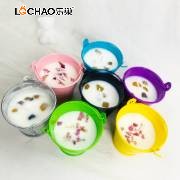The burning time of scented candles is a complex issue, primarily determined by the following core factors:
I. Core Factors
1. Wax Material (The Most Crucial Factor)
Different wax materials have different melting points and densities, directly determining the burning speed.
* **Soy Wax:** A natural plant wax with a low melting point (typically 50-55°C), it burns slowly, thus typically having the longest burning time. It's the first choice for those seeking a long burn.
* **Beeswax:** A natural wax with a hard texture and a slightly higher melting point than soy wax. It burns very slowly, has a long burning time, and produces negative ions during combustion, purifying the air.
* **Paraswax:** Extracted from petroleum, it has a wide melting point range (typically 50-60°C for candles), a softer texture, and usually burns faster than soy wax and beeswax, resulting in a relatively shorter
burning time. However, high-quality paraffin wax candles can also perform well.
* **Coconut Wax:** Often mixed with soy wax, it has a low melting point, a very soft texture, a slow burning speed, and a long burning time.
• Carnauba wax: Has a unique crystalline pattern and burning characteristics similar to soy wax.
Approximate burning time comparison (for equal volumes): Soy wax/coconut wax ≈ Beeswax > Paraffin wax
2. Candle size and wick
This is a "supply and demand balance" relationship.
• Candle diameter: The larger the diameter, the larger the molten pool needs to be to achieve uniform burning. If the wick is too small, it will produce "tunneling," meaning the wax only burns in the center,
wasting wax and shortening the effective burning time.
• Wick type and size: A wick that is too thin or has poor oil absorption will result in a small flame and insufficient molten pool; a wick that is too thick will result in an excessively large flame, burning too quickly
and producing black smoke. A suitable wick perfectly matches the candle diameter, ensuring complete and stable burning.
3. Fragrance and dyes
• Fragrance: The higher the concentration of added fragrance, the more wax base may be required, which can sometimes affect the burning speed. Some fragrance components themselves may also slightly
alter the burning characteristics of the wax.
• Dyes: Added dyes, especially certain chemical dyes, may clog the wick fibers, affecting essential oil absorption and leading to incomplete combustion, thus impacting burning time and efficiency.
II. External Factors and Usage Habits
4. Environmental Factors
• Ventilation: Being in a well-ventilated area or near a draft will cause the flame to flicker and burn more vigorously, accelerating combustion and shortening burning time.
• Ambient Temperature: In colder environments, the candle needs to consume more energy to melt the surrounding cold wax, which may slightly affect initial burning efficiency.
5. Usage and Maintenance Habits (Very Important!) Incorrect usage will significantly shorten the candle's "effective" burning time.
• First Burn: Crucial! The first burn must ensure that the surface wax is completely melted, forming a smooth, edge-to-edge pool. This usually requires burning for 2-3 hours or more. If the first burn is insufficient, a "memory ring" will form, where only the center burns, and the surrounding wax is not burned, resulting in significant waste.
• Wick Trimming: Before each lighting, trim the wick to about 5-6 millimeters. An excessively long wick will produce an excessively large flame and black smoke, causing the wax to burn too quickly.
* Burning Time: Each burn is recommended to be between 2-4 hours. Too short a burn will prevent the formation of a complete molten pool, while too long a burn may overheat the container and cause excessive carbonization of the wick, affecting subsequent burning.
* Placement: Ensure the candle is placed on a flat, windless surface, away from flammable materials.
Summary:
* Intrinsic Factors: The wax base material is the "ceiling" determining the burning time.
* Core Design: The matching of candle size and wick is the key engineering design that determines whether this "ceiling" can be reached.
* Post-Current Care: Your usage habits (especially the first burn and wick trimming) determine whether the candle's actual performance approaches its theoretical optimal burning time.
Therefore, a scented candle made of soy wax/beeswax with a well-matched wick, and which you use and maintain correctly, will certainly provide you with the longest and most enjoyable burning experience.





